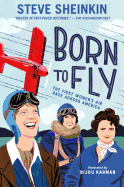
Who better to tell young adults the story of 1929's Women's Air Derby than the singular Steve Sheinkin? The author of historical deep dives that include the National Book Award finalists The Port Chicago 50 and Most Dangerous, Sheinkin is a history writer of unusual gumption and no shortage of nerve. In Born to Fly: The First Women's Air Race Across America, his inaugural woman-centered work of nonfiction, Sheinkin calls "Ladybirds," "Derbyettes" and other press-coined euphemisms for female pilots "patronizing and stupid."
Sheinkin begins by introducing his all-female cast of characters, evoking Little Rascals episodes with scenes of their youthful attempts at flight (as from the roof of a barn). As adults, these female pilots, relative rarities in a male-dominated field, are thrilled when they learn that on August 18, 1929, there will be a Women's Air Derby--the first-ever women's cross-country air race. This was the 1920s, when air racing was a wildly popular American spectator sport, so of course the derby would generate headlines. What the pilots could not have anticipated was how rage-makingly sexist the reporting would be.
Born to Fly is full of emergency landings, nail-biting finishes and (probable) acts of sabotage; when there isn't an archival photo to capture a moment, Bijou Karman's unpretentious line art fills in the gaps. But Sheinkin isn't just good at staging drama: he shoehorns in some basic aviation science while also setting the historical scene. Can it be a coincidence that the spike in women's interest in flying happened so soon after women won the right to vote? Sheinkin thinks not. --Nell Beram, freelance writer and YA author

